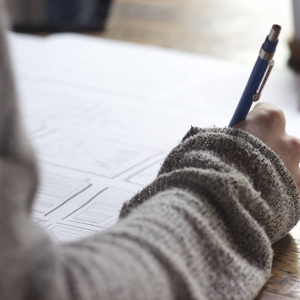Color is what we see because of reflected light. Light contains different wavelengths of energy that our eyes and brain “see” as different colors. When light hits an object, we see the colored light that reflects off the object.
Red, blue, and yellow are the primary colors. With paints of just these three colors, artists can mix them to create all the other colors. When artists mix pigments of the primary colors, they make secondary colors.
Red + Blue = Purple
Red + Yellow = Orange
Blue + Yellow = Green
Did you know that your computer screen also works by using three primary colors? But here, since the colors are light from the monitor and not paints, the three primaries are not the same. Instead, your computer screen mixes other colors from red, blue, and green.
One important thing painters know: using complementary colors—the ones across from each other on the color wheel (red-green, blue-orange, and yellow-purple)—make both colors seem brighter and more intense. They seem to vibrate and pop out at you, the viewer.
Warm colors—reds, yellows, oranges, and red-violets—are those of fire and the sun. They appear to project. Cool colors—blues, blue-greens, and blue-violets—are those of ice and the ocean. They appear to recede.
Claude Monet
French artist Claude Monet liked to paint the same subject over and over again, at different times of day and in different types of weather. He painted Rouen cathedral in France some thirty times, but what fascinated him most was not the building—it was, he said, the surrounding atmosphere. Rather than quick studies of changing light effects, these pictures, slowly reworked in the studio, are carefully considered explorations of color and mood:
- Each painting uses Rouen Cathedral to record time (morning or late afternoon) and weather (sunlight or mist). Examine the way Monet used color and texture: Can you tell from the shadows in the doorways which painting might have been done in the morning and which in the afternoon? (Don’t forget that the sun rises in the east and these paintings show the west façade or front of the building.) How do the colors change in sunlight, fog, and mist?
- Do you see any clear outlines? Is it possible to determine exactly where one surface ends and another begins? If line does not define the forms in this painting, what does?
Matisse
Around 1905 several artists, including Matisse, exhibited pictures in which heightened color was used to express a strong emotional response to nature. The painters were called “fauves,” or wild beasts. The freshness and strength of the tones in Open Window, Collioure are typical of the fauves; Matisse’s contrasts are subtle, giving this work a sense of serenity and radiance. Show students this painting (second to last image in the slideshow) to answer the following questions:
- Would you rather go sailing or stay in your cool room admiring the view?
- Describe the colors. How are they different from what you see in nature? What color would you usually use to color the ocean? Have you ever seen a pink sea? (Perhaps if it’s reflecting a sunset…)
- How big do you think this painting is? It’s actually only 21 3/4 x 18 1/8 inches. See how Matisse transformed the effect of a small canvas into expansive pictorial space through the device of the open window and eye-popping color.
Activity
Monet painted this photograph of the west façade of Rouen Cathedral in Paris. He painted this shape at different times of day and all types of weather. Students will select a time of day and type of weather and then color over this faded image using appropriate hues in oil pastel (preferable to cover image, but crayons could also be used).
- What colors show sunrises?
- What colors show fall?
- What colors show snowfall?
Use one or more photographs to explore how the same shape can show different colors at different times.







